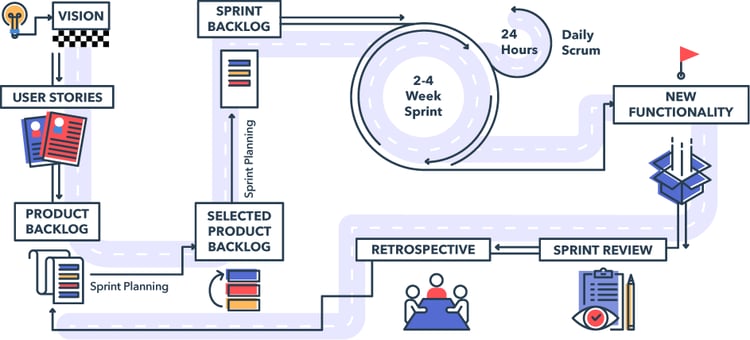Agile has become the first choice of development teams when it comes to speedy development and quality assurance throughout the software development life cycle. Before agile, the waterfall was the main methodology used for developing a product. This methodology focused on defining and negotiating the contract and the project’s scope before starting with the development.
While this may seem like a feasible approach to software development, the main shortcoming is the rigidity that adds. Moreover, you only get the product after the project is completed, which might sometimes take years.
This is where agile comes in.
It not only solves the problem of rigidity and increased timelines but also adds flexibility to incorporate changes in the product during the development. There are several other advantages of agile software development methodology. Before discussing that, let’s first understand what agile software development is.
What is Agile Software Development?
Agile is a methodology of working that promotes speed and efficiency. Agile can be used to define different things. You can be an agile practitioner as an individual, have agile teams, call yourself an agile organization. Or, you may be following the agile methodology in your processes or might have adopted agile as a way of working.
But here, we are talking specifically about agile software development.
Agile software development means adopting a step-by-step development approach where each step acts as a mini version of the project. The development is broken down into different sprints containing different goals. At the completion of each sprint, the software is passed on to the client, who offers his feedback. Based on the input, the team can either take up the changes requested or move to the next sprint/phase in the development process.
9c4b.png)
Essentially, agile eliminates the rigidity that one faces in the waterfall method. There is more flexibility and freedom to change the project’s scope even after the contract is signed.
Unlike the waterfall approach, agile development does not wait for one part of the process to complete before moving towards the next one. In agile, software development follows an iterative approach.
One can see overlaps or enhancements in design, development, testing, and other specific phases. Each of the phases involves the development of a new feature or the expansion of the existing one. The client receives continuous delivery of the product through different sprints and testing environments.
It is based on the 12 principles mentioned in the Manifesto for Agile Software Development. Following the twelve principles in software development enables teams to focus more on figuring out the right things to do throughout the process.
12 Principles of Manifesto for Agile Software Development
The agile manifesto was developed in 2001 by a team of 17 software developers. They were independent-minded software practitioners who found a consensus and created the Agile Manifesto, which read as:
We are uncovering better ways of developing software by doing it and helping others do it.
Through this work, we have come to value:
Individuals and interactions over processes and tools
Working software over comprehensive documentation
Customer collaboration over contract negotiation
Responding to change over following a plan
That is, while there is value in the items on the right, we value the items on the left more.
The manifesto has 12 principles which are as follows:
-
Delighting customers with early & continuous delivery is the highest priority.
-
Changes in software development are always welcome.
-
Shorten the delivery time cycle and release working software every few weeks/months.
-
Developers & business people should work together on the project.
-
Trust individuals to get the job done by providing the required environment.
-
A face-to-face conversation is the most effective way of conveying information.
-
Progress in the project should be measured based on the working software.
-
Agile is all about sustainability in development. All those involved in the team should be able to work at their own pace.
-
Promote technical excellence and design expertise with continuous attention.
-
Believe in simplicity in the project.
-
Motivate teams to be self-organizing to yield the best results in terms of design and architecture.
-
Teams should reflect on improving themselves & becoming more efficient at regular intervals.
Also Read: Getting Started With Distributed Agile Development: A Guide
Agile Software Development Process Flow
In order to understand the advantages of agile software development, one needs to understand the process flow of this approach. The flow goes in iteration, and after every review and retrospective meeting of each sprint, the team starts with the sprint planning once again.
-
Project Planning & Roadmap Creation: After research, you plan the project and create the roadmap for development.
-
Release Planning: You break the development into different milestones and plan the release for the release of each functionality.
-
Sprint Planning: Here, you plan with each team member about the tasks they need to complete within the sprint and what their deliverables are.
-
Daily Scrum Meetings: During the entire process and each sprint, one holds a daily scrum meeting to review progress and discuss any bottlenecks in the process.
-
Development Of New Functionality: The new functionality is developed by the team, and the software is ready to be delivered with this enhancement.
-
Sprint Review: The deliverable is sent to the client after QA and testing, and the feedback is much appreciated from them.
-
Retrospective Meeting: The development team, Scrum Master, product owner, and the client sit together to retrospect the process and plan the next sprint, and the same process repeats.
In general, the software development lifecycle of agile development isn’t very different from the traditional software development process. The difference lies in the deliverables and timelines. While traditional promises a completed product delivered at the end of the project, agile delivered new functionalities in iterations after each sprint.

Each sprint lasts about 2-4 weeks and solicits feedback from the client at the end. The client receives a functionality or part of the software at the end of the sprint. Any changes can be accommodated in the upcoming sprints and the development continues with iterations and increments, each iteration leading to enhancements in the previous one.
| Factor | Agile Software Development | Traditional Software Development |
| Flexibility | Flexible to changes throughout the development process | Does not welcome any change after the contract |
| Approach | Iterative & Incremental Approach | Linear Approach |
| Adaptability | Has the provision to adopt changes | Scope of the software is defined initially and no provision for adaptability later |
| Iteration | Various iteration cycles based on sprints which are usually for about two weeks | Iterations are welcomed only once the entire product is developed and delivered |
| Project Size | Can be used for project of any size | Recommended for small projects to minimize the margin or re-work or error |
| Deliverables | Working product delivered after each sprint | Fully working and finished product delivered at the end |
| Dependency | Limited dependency | Strict dependency on people, processes, technology, etc. |
When it comes to digital product development, taking the agile approach helps a lot. Clients or product owners can receive value delivered by the software development company at an increased pace by becoming agile.
But that’s not all. There are several other advantages of agile software development approach in 2021. Let’s find out.
Also Read: Top 10 Software Outsourcing Companies In 2021
Benefits Of Agile Software Development
Following the agile approach in software development means getting a project out within the set time frame while also ensuring value creation. So, let's check out the 10 advantages of agile software development approach that you can enjoy if you plan to adopt this methodology.
#1. Efficient Change Management
Any regular software development approach does not offer the flexibility to accept change in the project. The deliverables, timelines, technologies, and the approach mentioned in the outsourcing contract’s SLDC remain rigid. However, during the duration, the technologies, priorities, or even deliverable requirements might change. Anything other than the agile approach in software development does not allow such changes.
Most of the stakeholders get to see the software only after the complete development. And if there are any changes required once the company has delivered the product, making any new changes might incur extra charges.

However, this is not the case with agile software development. Stakeholders are constantly involved in the process. Each sprint ends with the project being shared with the client, and any changes they share can be easily incorporated and implemented in the upcoming sprint.
With Agile software development, one gets the work done in iterations. This means that the teams have the opportunity to refine the product/feature developed in the previous iteration or sprint in the coming weeks. There is a greater bandwidth to accommodate changes in agile software development as it offers the timeframes that can incorporate any changes in the next sprints.
#2. Adds Transparency In Development Process
As agile approach in the development encourages stakeholders to participate in the process ad know what’s happening in which sprint. Whether it is about prioritizing the software features, sanctioning different sprints, iterations, reviews, or planning for different version launches, stakeholders enjoy complete participation in the process.
This boosts the transparency in the project as the clients are completely aware of the work in progress in each sprint.
#3. Minimizes Re-Work
In waterfall, if there is any change required at any level of the software, the entire product gets affected. Most probable, the entire codes need to be changed to accommodate even a slight change in the software. This not only increases the work that needs to be done but also wastes a lot of time and effort.
With agile, the product teams work in iterations. And after each sprint, the client gets to view the progress or the features developed. If they find any issue with the same or just want a slight change, it can be easily adjusted in the upcoming sprint. And the change would be reflected in the coming few weeks. As you take the MVP development approach, this minimizes all the work that might go in if the developers are working in waterfall and need to backtrack all the codes and start from scratch again.
#4. Adds Flexibility In Development
Products that are developed in a rigid workflow usually end up requiring complete re-work in case of even the slightest issue or change requirement. With an agile software development approach, you can add flexibility to the process. Not just the development teams but even the stakeholders get flexibility with the agile process.
In case of any change requirements, the teams can easily adopt the same in the next sprint without worrying about creating technical debt. Agile software development gives you the ability to go backward and make changes in the previous functionality released in an earlier sprint. It even ensures that the product released is exactly what the customer required.
#5. Eliminates Micromangement
At the heart of agile, the aim is to grow a team that is resilient to any change in the project. Agile frameworks like Scrum, Crystal, etc., focus on team management. It helps define clear team roles and responsibilities within the SLDC.
Each one of the team members knows what they are expected to take up in each sprint and eliminates micromanagement. Moreover, the boosted collaboration through daily scrums, documentation, and reporting ensures one does not need a manager to constantly follow up on the things delivered, pending, unresolved issues, etc.

#6. Reduces Risk
As the customer’s vision is incorporated within the different sprints throughout the software development life cycle, the chances of project failure reduce to a fraction. The iterative and incremental approach adopted by agile software development prepares the teams well in advance to make changes required by the client through stories of product & sprint backlog. The risk of delivering a fully-finished product at the end, and having the client not love it, is reduced in agile.
#7. Boost Collaboration
The silo mentality is one of the biggest challenges that hamper the growth of an organization as well as individuals. It creates knowledge banks among certain sets of employees while preventing others from accessing the knowledge. Agile, on the contrary, promotes collaboration. People are supposed to hold daily meetings, share the reports, and prepare documentation where everyone can notice the same. The teams are self-organizing that collaborate continuously for continuous improvement.

#8. Enhances The Project Predictability
There is increased visibility in the project owing to the transparency offered by agile methodology. The sprint backlogs, user stories, and other things ensure that one knows what is happening in the project beforehand. Project managers can predict the risks and performance of the teams more effectively with agile. Not just that, agile also enables the product managers and owners to predict timelines and the success to plan the timeline and next sprints.
#9. Helps Achieve Technical Excellence
Through continuous improvement, agile fosters excellence in the SLDC. This methodology enables the project teams to work in iterations, achieving better results than the previous sprint. This enables the teams to achieve technical excellence in terms of quality of codes, bug-free functionality, and other relevant metrics that ensure customer/user satisfaction.
#10. Enhances Stakeholder Engagement
Agile promotes collaboration not just within teams but also with external stakeholders. The sprints throughout the development process are preceded and followed by a discussion with the client. They are not alienated from the product team and can keep a close tab on the progress in the development.
Considerations In Agile Software Development
When going for agile software development, there are many considerations that you should know to be able to leverage the methodology better. Most companies simply jump into agile software development after hearing the various benefits that it can offer.
Ensure Agile Mindset Throughout Organization
To fully embrace agile for software development, it is imperative that not just one team member, department, developer, or manager become an agile practitioner. But agile should be embraced as a whole as an organization’s mindset. For example, it is crucial to break down the siloed mentality, embrace collaborative tools, foster open culture, and adopt agile as a whole. Additionally, stakeholders need to be involved throughout to give their feedback and support the incremental approach.
Choose The Right Agile Framework
There are several agile frameworks that might confuse you. You need to be able to choose the right agile framework that goes with your end goals and your company’s culture. Some of the agile frameworks are:
-
Scrum: One of the most popular agile frameworks, Scrum is best when planning to implement the responsiveness of agile. It focuses on the team’s roles & responsibilities in a project.
-
Kanban: This is another popular agile framework that focuses on the agile workflows in the project through the Kanan board. It eliminates any issues that might hamper the project’s efficiency.
-
XP: Extreme Programming focuses on frequent release and ensures continuous delivery in the software development cycle.
-
Crystal: This framework adds value to the project by focusing on key decision making and reducing time & efforts spent on micro-management, reporting, and documentation.
-
FDD: Feature-Driven Development is another agile framework that focuses more on stakeholder engagement throughout the development process.
-
DSDM: Also known as Dynamic Systems Development Method, this framework delivers continuous value to fulfill project goals in required timelines.
Plan Each Sprint Carefully
Agile is all about continuous delivery through different sprints. Hence, it is imperative that you hire a project manager or a Scrum master to plan the sprints carefully. Each sprint should be a milestone and act as an enhancement to the previous version. Moreover, each sprint backlog, stakeholder feedback, and other things need to be included in the next sprint planning.
Hold Team Meetings Daily
Collaboration and communication are the two pillars of a successful agile software development process. And this is possible through daily scrum meetings. With this methodology, one has defined each team member’s roles & responsibilities beforehand during the sprint planning. However, holding daily standup meetings or scrum meetings eliminates any confusion and gives the managers a gist of the progress or issues in the same.
5a6a.png)
Make Sure There Is No Technical Debt
There could be a huge technical debt if you start accumulating all the product backlog from the previous sprints. Many companies following the agile approach solely focus on the new functionalities in each sprint without evaluating the sprint and product backlog. This technical debt could totally nullify the main reason why people choose agile software development in the first place. So, you need to fix each issue during the sprints to avoid accumulating technical debt that could take down your product.
Adopt Agile As A Culture
One should ensure that agile is not just for a one-time project or a part of the development. You should even ensure that agile is not just adapted for a particular team, individual, or department in the organization. It should be adopted as a company culture that fosters the idea of open working and collaboration among everyone.
Mistakes In Agile Software Development
Not everyone is completely aware of the agile approach to software development. Many have aced it, while others are still getting the hang of the approach. And whenever you initiate anything new, mistakes are bound to happen. This is what we will be discussing in this section. However, along with the mistakes, we will also talk about their solutions and how you should amend the same.
Also Read: Key Questions To Ask Before Choosing An Agile Development Company
Not Having A Scrum Master In TheTeam
Many companies feel that they can implement the agile approach of software development with the team and tools they have in place. They disregard the importance of a scrum master in the team and if they do hire one, they hire them on a part-time basis. Many even hire a scrum master and bombard them with the responsibility of collaborating between various stakeholders and their respective teams.
Solution:
It is essential that you hire a dedicated scrum master for each project that you undertake. Moreover, they should not be asked to undertake other functions as well in the project. The role of a scrum master should be well-defined in software development.
They are responsible for improving the process, continuous flow of software, and establishing a high-performing team dynamic. They should be experts in Scrum, train others in the same, and arrange team meetings at the right intervals to boost collaboration.
Focusing Only On The Process & Tools
Many companies think that agile software development is all about changing the process and incorporating new tools to boost collaboration among different teams. They become more about the processes and tools and less about the people being agile practitioners. This takes the core of agile philosophy away from the organization’s long-term goals.
Solution:
No doubt that companies should focus on their tools and the processes that they are following. However, this should not take the complete focus off the people. Companies should ensure that agile is more about communication and collaboration. If they can make their people agile practitioners, the processes will automatically improve, and so will the usage of tools.
Not Enough Agile Training
Companies consider agile as a part of software development and feel that the product teams would automatically get familiar with this methodology. Not just that, many companies, after hiring agile practitioners, make the mistake of letting them miss out on the agile training. This could lead to several confusions and lack of collaboration cause each company follows its own version of Agile philosophy.
Solution
Make sure to offer complete Agile training at the time of onboarding so that the software developers and others on the team are aligned to your agile philosophy. Each one should know what is expected of them and their team in the software development process. Make them aware of the tools you use and the process approach you follow. Even the agile practitioners you hire should be re-trained to align them with your processes.
Not Accepting Agile As A Company Culture
Not informing the product team about the move to an agile methodology could be one of the biggest mistakes you can make. Agile breaks organizational silos and brings everyone together on the same platform in one development project. It may not be easy to adapt for everyone, and it can create resistance to change even among multiple employees. They may not be ready to respond to change or say goodbye to the old way of working.
Solution
It is imperative that you create a company culture and make each one agile practitioner. Each department, whether it is an IT or non-IT department, should be encouraged to become agile and follow the agile philosophy. Propagate collaboration, an open working environment, direct communication, and accountability of each individual to inculcate a culture of agile.
Inadequate Customer Engagement
Not letting the customers be engaged with the process is one of the biggest mistakes that can cost you a lot of money and re-work on the product. Many companies only focus on the feedback that they receive from the internal teams. However, this is not what agile promotes. By leaving the customers out of the feedback loop and engagement, one is totally going against what agile stands for, which is enhanced stakeholder engagement.
Solution:
Agile is all about collaboration and continuous delivery. You need to engage the customer in the development process and solicit feedback from them. Every time you send the delivery to the customer, make sure to get feedback from them on the same. Moreover, make sure that you have discussed early on the extent of engagement and the tools for engagement with the customer to avoid any miscommunication. Taking the iterative approach of agile software development with MVP can certainly help save money.
Finding An Agile Software Development Partner
Agile development requires a software development partner that has mastered the culture and methodology of agile. With the right partner, you can get closer to achieving the goal of technical excellence with agile. The benefits and considerations mentioned above can ensure success with an agile approach. However, with the right CTO, technology partner, or technical co-founder for startups, one can reap all the benefits without making any mistakes.
At Classic Informatics, we have been agile practitioners since the start. We are not just agile in our software development processes, but that’s how we work as independent teams through all departments. Our focus lies on collaboration, communication, fast decision cycles, and rapid learning to achieve tangible results. We follow a sprint-based approach that enables us to iterate fast and in an incremental way to release working products faster, even within weeks.
You can contact us anytime to discuss the project requirements and get our project teams to get started with the project. We have a complete technology stack to power all types of digital products like websites, web apps, mobile apps, SaaS products, software apps, AI/blockchain/ML/data-centric apps, and much more.























.png)



